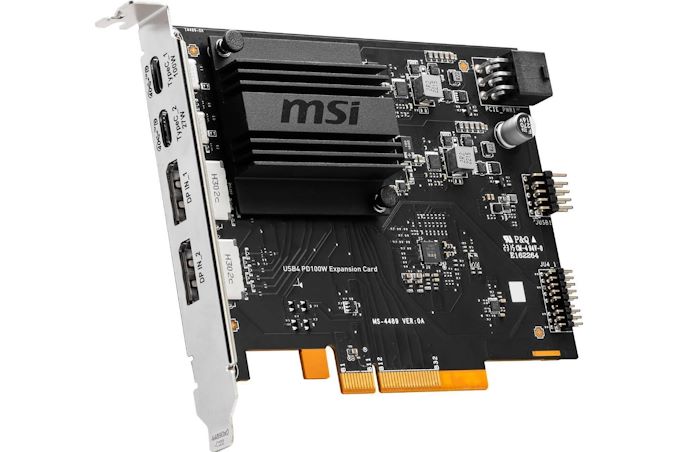MSI Intros USB4 PCIe Expansion Card with 100W Power Delivery
by Anton Shilov on May 31, 2023 7:00 AM EST- Posted in
- Motherboards
- MSI
- USB4
- Computex 2023

For Computex 2023, MSI is introducing an interesting USB4 PCIe expansion card. The card not only offers two full-bandwidth USB4 40Gbps Type-C ports, but the card can also deliver up to 100W of power to a device connected to it, allowing it to be used to power high-drain devices like laptops.
The MSI USB4 PD100W Expansion Card (MS-4489) has two DisplayPort inputs as well as two USB Type-C connectors. The Type-C ports support USB data rates up to40 Gbps, but also supports DP alt mode and USB power delivery.
What really makes this card notable are those power delivery capabilities; most USB4/Thunderbolt 4 expansion cards are PCIe bus-powered, and can only deliver up to 15 Watts or so. MSI's card, on the other hand, can deliver up to 100 Watts of power on its best Type-C port, which is enough power for charging a high-performance notebook or powering something demanding (e.g., a display). Meanwhile the card's second Type-C port can deliver up to 27 Watts, which is enough for smartphones and other mid-power periphreals.
The card uses a physical PCIe x8 form factor, with what looks to be an electrical x4 interface. MSI has disclosed that it's using a PCIe 4.0 connection, though for they moment they have't disclosed whose USB4 controller they're using. PCIe 4.0 x4 is sufficient to fully drive a 40Gbps port and then some; but it'll fall a bit short of simulaneously driving both ports at their maximum data transfer rates (assuming you even have a workload that can fully saturate the links).
Menawhile, as this USB4 host card goes above and beyond the amount of power a PCIe slot can provide, the card also has a six-pin auxiliary PCIe connector to supply the remaining power. Per the PCIe specificaiton, a x4 card can draw up to 25W from the slot, so the 75W auxillery connector brings the card to its 100W limit. Though this also means that if MSI is sticking to the PCIe spec, then they can't deliver a full 100W + 27W at the same time.
MSI's USB4 PD100W Expansion Card is mainly aimed at users who need to attach bandwidth demanding peripherals (such as direct attached storage or some professional equipment) and USB-C displays to their desktop PCs. The board will serve equally well both the latest PCs that do not support USB4 connectors (or need extra Type-C ports) and machines that are already is use and need to gain advanced connectivity.
MSI does not disclose pricing of its USB4 expansion card or when it is set to be available, though we would expect it to be priced competitively against similar Thunderbolt 3/4 expansion cards that have been available for some time.
Source: MSI










19 Comments
View All Comments
ikjadoon - Wednesday, May 31, 2023 - link
Do these USB4 expansion cards support all motherboards?IIRC, all the Thunderbolt expansion cards require extremely specific motherboards with Thunderbolt headers, which make them less expansion cards and more motherboard daughterboards.
Kevin G - Wednesday, May 31, 2023 - link
Looking at the picture in the article, the card has a TB header on it to connect to the motherboard.abufrejoval - Wednesday, May 31, 2023 - link
ACQ NICs not nice, need editCharonSin - Friday, July 14, 2023 - link
Excellent point.herozeros - Wednesday, May 31, 2023 - link
All the TB4 cards (gigabyte, asus et al) have Thunderbolt 4 cards that support power delivery via psu power NOT just bus powered. Not sure why this card is so special because it does 100w PD.repoman27 - Thursday, June 1, 2023 - link
^This.Gigabyte GC-MAPLE RIDGE and ASUS ThunderboltEX 4 add-in cards have exactly the same Power Delivery specs. The Gigabyte card even has 2x 6-pin PCIe power connectors so you can fully power the ports without using any slot power.
abufrejoval - Wednesday, May 31, 2023 - link
Why on Earth are vendors designing extra long boards like these?Plenty boards have an extra x4 slot, x8 is far harder to find or requires bifurcation.... So why?
It's similar with ACQ113 nice, which only require x1 on PCI 4, but nearly always come with a physical x2 connector, which is practically non-existent on Mainboards while underused x1 slots abound...
Seems like they really do not want to sell these or worse!
LiKenun - Wednesday, May 31, 2023 - link
Thunderbolt 4 requires 4 lanes of PCIe 3.0 bandwidth. Thus, 8 lanes are required to support 2 ports.The real question is why they aren’t designing them to use 2 PCIe 5.0 lanes?
Kevin G - Thursday, June 1, 2023 - link
Power consumption is the likely reason why. 4x and higher PCIe slots are permitted to pull more amps off of the 12V power in the slot. Physical slots do have to adhere to the power requirements even if they don't provide the full bandwidth. For example a physical 16x slot but wires 1x electrically still has to provide up to 75W across the slot.DanNeely - Thursday, June 1, 2023 - link
This card is electrically x4 and mechanically x8; which doesn't get it it anything power wise. x4 and x8 are both 25W from the slot.Maybe the extra length is just for increased stability to reduce the risk of half-unseating the card while pulling a cable out of the card. A lot of x4 slots are open backed allowing longer cards to be inserted; but a PCB notch to allow it to install in close backed slots would have improved compatibility here.